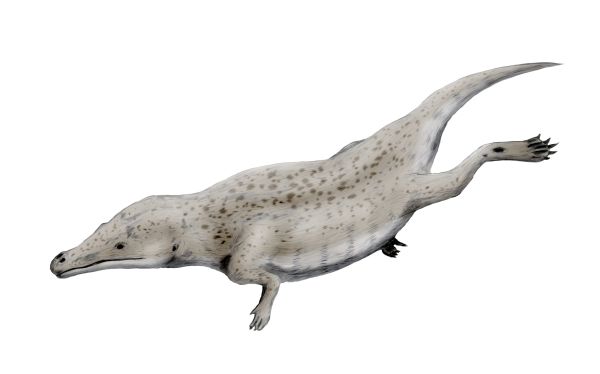Maiacetus inuus (Good Mother Whale)
Welcome!
Thank you for visiting our website.
This site was created for Organismal Biology
at UW – La Crosse.
Katelyn Marks and Brittany Dziki
An interesting question that intrigued many paleontologists was
how did the modern day whale make the transition from land to
sea? The answer to this transition could not be comprehended
without an organism that was amphibious to provide an
intermediate stage in the transition. In 2000 through 2004
scientists found evidence of an organism that had the
modifications of the land-mammal body and its supporting
skeleton to enable whales to swim efficiently in water. The new
organism that they discovered became known as the Maiacetus
inuus or the Good Mother Whale.

The discovery, made by Philip Gingrich, of two skeletons in
Kunvit, an eastern Balochistan Province of Pakistan filled in
the gaps in the whale’s land-to-water transition (Gingrich et
al. 2009). The discovery of the skeletons was huge to the
paleontology world. The first skeleton contained a near-term
fetus and the second skeleton was near complete. The fetal
skeleton preserved within the ribcage of the mother is
interpreted as a fetal skeleton rather than an indigested meal
because, there was no damage to the fetal skull (Gingerich et al.
2009). The fetus was positioned inside the mother for head-first
delivery, giving another clue to paleontologists that female
Maiacetus inuus had to return to land to give birth (Gingerich
et al. 2009).
The reconstruction of the 47-million-year-old protocetid archaeocete Maiacetus inuus (Gingerich et al. 2012) was able to provide paleontologists with answers to many of their questions regarding the cetacean family tree. We encourage you to read and explore the classification to become more familiar on Maiacetus inuus and how this ancient animal helped to fill in the fossil gap.
View multiple other interesting organisms at multipleorganisms.net.
Photo credit for our header picture on all of our pages goes to http://commons.wikimedia.org/wiki/File:Maiacetus_inuus.jpg.